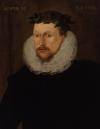Furtherreading
Other info : Bibliography
- Alfred Harbage, Annals of English Drama 975-1700 (Philadelphia: University of Pennsylvania Press / London: Oxford University Press, 1940); second edition, revised by Samuel Schoenbaum (Philadelphia: University of Pennsylvania Press, 1964).
- Richard F. Hardin, "Michael Drayton," in The Popular School, edited by T. P. Logan and S. S. Smith (Lincoln: University of Nebraska Press, 1975), pp. 137-147.
- James L. Harner, Samuel Daniel and Michael Drayton: A Reference Guide (Boston: G. K. Hall, 1980).
- Kathleen Tillotson, "Drayton and the Gooderes," Modern Language Review, 35 (July 1940): 341-349.
- Bernard Newdigate, Michael Drayton and his Circle (Oxford: Blackwell, 1941; revised, 1961).
- Dick Taylor, "Drayton and the Countess of Bedford," Studies in Philology, 49 (April 1952): 214-228.
- Anne Barton, "Harking Back to Elizabeth: Ben Jonson and Caroline Nostalgia," ELH, 48 (Winter 1981): 706-731.
- Jean R. Brink, Michael Drayton Revisited (Boston: Twayne, 1990).
- Michael D. Bristol, "Structural Patterns in Two Elizabethan Pastorals," Studies in English Literature, 10 (Winter 1970): 33-48.
- John Buxton, A Tradition of Poetry (New York: Macmillan, 1967).
- Lilly B. Campbell, Divine Poetry and Drama in Sixteenth-Century England (Cambridge: University Press / Berkeley: University of California Press, 1959).
- Campbell, "The Use of Historical Patterns in the Reign of Elizabeth," Huntington Library Quarterly, 1 (January 1938): 135-167.
- Katherine D. Carter, "Drayton's Craftsmanship: The Encomium and the Blazon in Englands Heroicall Epistles," Huntington Library Quarterly, 38 (August 1975): 297-314.
- Walter R. Davis, "'Fantastickly I sing': Drayton's Idea of 1619," Studies in Philology, 66 (April 1969): 204-216.
- M. J. Dickson, "William Trevell and the Whitefriars Theatre," Review of English Studies, 6 (July 1930): 309-312.
- Margaret Dowling, "Further Notes on William Trevell," Review of English Studies, 6 (October 1930): 443-446.
- Parker Duchemin, "Barbarous Ignorance and Base Detraction: The Struggles of Michael Drayton," Albion, 14 (Summer 1982): 118-138.
- Duchemin, "Poly-Olbion and the Alexandrine Couplet," Studies in Philology, 77 (Spring 1980): 145-160.
- Barbara C. Ewell, "Drayton's Endimion and Phoebe: An Allegory of Aesthetics," Explorations in Renaissance Culture, 7 (1981): 15-26.
- Ewell, "Drayton's Poly-Olbion: England's Body Immortalized," Studies in Philology, 75 (Summer 1978): 297-315.
- Ewell, "From Idea to Act: The New Aesthetics of Drayton's Englands Heroicall Epistles," Journal of English and Germanic Philology, 82 (October 1983): 515-525.
- Ewell, "Unity and the Transformation of Drayton's Poetics in Englands Heroicall Epistles," Modern Language Quarterly, 44 (September 1983): 231-250.
- Scott Giantvalley, "Barnfield, Drayton, and Marlowe: Homoeroticism and Homosexuality in Elizabethan Literature," Pacific Coast Philology, 16 (1981): 9-24.
- Joan Grundy, "'Brave Translunary Things,'" Modern Language Review, 59 (October 1964): 501-510.
- Grundy, The Spenserian Poets (London: Edward Arnold, 1969).
- Richard F. Hardin, Michael Drayton and the Passing of Elizabethan England (Lawrence: University of Kansas Press, 1973).
- Richard Helgerson, Self-Crowned Laureates (Berkeley & Los Angeles: University of California Press, 1983).
- Wyman Herendeen, From Landscape to Literature: The River and the Myth of Geography (Pittsburgh: Duquesne University Press, 1986).
- Geoffrey G. Hiller, "Drayton's Muses Elizium: A New Way over Parnassus," Review of English Studies, 21 (February 1970): 1-13.
- Clark Hulse, Metamorphic Verse: The Elizabethan Minor Epic (Princeton: Princeton University Press, 1981).
- Anthony LaBranche, "Drayton's The Barons Warres and the Rhetoric of Historical Poetry," Journal of English and Germanic Philology, 62, no.1 (1963): 82-95.
- LaBranche, "Poetry, History, and Oratory: The Renaissance Historical Poem," Studies in English Literature, 9 (Winter 1969): 1-19.
- Barbara Lewalski, "Lucy, Countess of Bedford: Images of a Jacobean Courtier and Patroness," in Politics of Discourse: The Literature and History of Seventeenth-Century England, edited by Kevin Sharpe and Steven Zwicker (Berkeley: University of California Press, 1987), pp. 52-77.
- David Norbrook, Poetry and Politics in the English Renaissance (London: Routledge & Kegan Paul, 1984).
- William A. Oram, "The Muses Elizium: A Late Golden World," Studies in Philology, 75 (Late Winter 1978): 10-31.
- Annabel Patterson, Censorship and Interpretation: The Conditions of Writing and Reading in Early Modern England (Madison: University of Wisconsin Press, 1985).
- Vincent F. Petronella, "Double Ecstasy in Drayton's Endimion and Phoebe," Studies in English Literature, 24 (Winter 1984): 87-104.
- Stella P. Redvard, "The Design of Nature in Drayton's Poly-Olbion," Studies in English Literature, 17 (Winter 1977): 105-117.
- Joan Rees, "Hogs, Gulls, and Englishmen: Drayton and the Virginian Voyages," Yearbook of English Studies, 13 (1983): 20-31.
- Kathleen Tillotson, "Drayton and Richard II: 1597-1600," Review of English Studies, 15 (April 1939): 172-179.
- Tillotson, "Michael Drayton as a 'Historian' in the 'Legend of Cromwell,'" Modern Language Review, 34 (April 1939): 186-200.
- Michael D. West, "Drayton's 'To the Virginian Voyage': From Heroic Pastoral to Mock-Heroic," Renaissance Quarterly, 24 (Winter 1971): 501-506.






